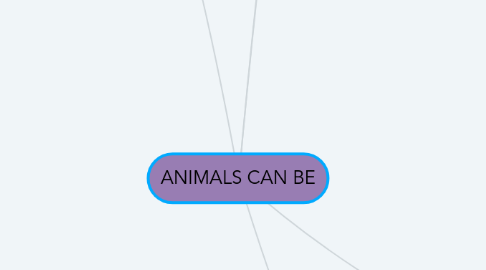
1. Vertebrates
1.1. They have a skeleton
1.2. They are classified into 6 groups
1.2.1. Fish
1.2.1.1. • They have a skeleton. They are vertebrates. • They are cold-blooded. • They take oxygen from the air in water with their gills. • Their bodies are covered in scales. • They lay eggs in the water. They are oviparous. • They can take care of themselves as soon as they are hatched. • They have a tail and fins to swim. Some kinds of fish can only live in salt water. Others live in fresh water.
1.2.1.1.1. Examples are mussels, oysters, cockles and scallops
1.2.2. Amphibians
1.2.2.1. • They have a skeleton. They are vertebrates. • They They are cold-blooded. • They live part of their lives in water, (when they are born), and part of their lives on land, (when they are adults). • They breathe through their skin and their gills, (when they are young), and through their skin and their lungs, (when they are adults). • Their skin is smooth and moist. • They lay eggs in the water. They are oviparous. They can take care of themselves as soon as they are hatched.
1.2.3. Birds
1.2.4. • They have a skeleton. They are vertebrates. • They are warm-blooded. • They breathe through their lungs. • Their bodies are covered in feathers. • They have a beak, two legs, two wings and a tail. • They hatch from eggs. They are oviparous. • They take care of their offspring until they are old enough to leave the nest.
1.2.5. Reptiles
1.2.5.1. • They have a skeleton. They are vertebrates. • They are cold-blooded. • They breathe with their lungs. • Their bodies are covered in scales: crocodile. • Some have a shell: tortoise. • Some have legs: lizard. • Others slither along the ground: snake. • They hatch from eggs. They are oviparous. • They take care of themselves immediately. • Most of them live on land, but some spend most of their lives in water. • They use heat from the sun to warm their bodies.
1.2.5.1.1. Examples are crabs, lobsters and shrimps
1.2.6. Mammals
1.2.6.1. • They have a skeleton. They are vertebrates. • They are warm-blooded. • They breathe through their lungs. • Their bodies are covered with hair or fur. • Most mammals grow inside their mother’s womb until they are born. They are viviparous. • When mammals are born, they are fed on their mothers’ milk. • They take care of their young for a long time. • They can walk, (bears), fly, (bats) or swim, (whales).
2. They have no skeleton
3. Depending on where they live
3.1. Domestic
3.1.1. They can live near people
3.2. Wild
3.2.1. They live in freedom
4. Depending on what they eat
4.1. Carnivores
4.1.1. They eat only meat
4.2. Herbivores
4.2.1. They eat only plants
4.3. Omnivores
4.3.1. The eat meat, fish and plants
5. Invertebrates
5.1. They are classified into 5 groups
5.1.1. Echinoderms
5.1.1.1. Examples are starfish and sea urchin
5.1.2. Worms
5.1.2.1. Examples are earthworms and tapeworms
5.1.3. Cnidarians
5.1.3.1. Examples are jellyfish, coral and anemone
5.1.4. Sponges
5.1.4.1. Examples are jellyfish, coral and anemone
5.1.5. Arthropods
5.1.5.1. Insects
5.1.5.1.1. Their body is divided in three parts: head, thorax, where they have six legs and two or four wings, and abdomen Examples are flies, butterflies, bees, wasps, ladybirds.
5.1.5.2. Arachnids
5.1.5.2.1. They have eight legs and their body is made up of two parts: the abdomen and the cephalothorax Examples are spiders and scorpions
5.1.5.2.2. Examples are mussels, oysters, cockles and scallops
5.1.5.3. Crustaceans
5.1.5.3.1. Examples are crabs, lobsters and shrimps
5.1.5.4. Myriapods
5.1.5.4.1. Examples are centipedes
5.1.5.5. Mollusc
5.1.5.6. Gastropods
5.1.5.6.1. Examples are snails, slugs and sea snails
5.1.5.7. Bibalbes
5.1.5.8. Cephalopods
5.1.5.8.1. Examples are squids, octopuses and cuttlefish
